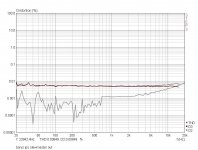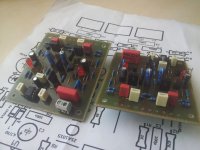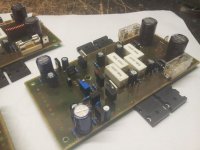Okay Thimios so you do have a separate power supply to drive the tube. I thought you would need to do something like that. I believe you that probably has a very distinct sound mixing the vacuum tube and ss parts. I just can't even think about having a tube inside a current consumer product.
I haven't tried the VSHA with borys' ops yet. Only with the slew mini ops. It doesn't have a cap multiplier either. I will try it with borys' ops tomorrow now that I have them working.
No, a separate power supply (6.3v)used for tube filaments only!Okay Thimios so you do have a separate power supply to drive the tube. I thought you would need to do something like that. I believe you that probably has a very distinct sound mixing the vacuum tube and ss parts. I just can't even think about having a tube inside a current consumer product.
Tube anode voltage is +50v (48v after capacitance multiplier),same as the Slewmaster output board.
Last edited:
Slewmasters = NO tubes.
What is all this fuss with the freakin' tubes ?
Just use a bloody (pair of) JFET's , same damn voltage controlled "sound" without
the cost , reliability , and extra electrical support issues !
The 30 year old Sansui "GLA" or "Kypton V" 3 stage VFA will be the
exact same with a better 2sk2145 matched Jfet and actually last
30+ years.
Would the Jfet SMD be any harder than the big ceramic tube socket
and 6V heater supply ? Besides the tube being harder I surely would
not want any microphonics (don't put yer' tube near a speaker).
OS
What is all this fuss with the freakin' tubes ?
Just use a bloody (pair of) JFET's , same damn voltage controlled "sound" without
the cost , reliability , and extra electrical support issues !
The 30 year old Sansui "GLA" or "Kypton V" 3 stage VFA will be the
exact same with a better 2sk2145 matched Jfet and actually last
30+ years.
Would the Jfet SMD be any harder than the big ceramic tube socket
and 6V heater supply ? Besides the tube being harder I surely would
not want any microphonics (don't put yer' tube near a speaker).
OS
OS,
The only piece of equipment that I have that has tubes is my old Mac MR71 tuner. Everything else is long gone.
The only piece of equipment that I have that has tubes is my old Mac MR71 tuner. Everything else is long gone.
I don't know if fet can give me the same or better sound.I know FOR SURE that this ,tube IPS ,reproduce deep strong full bass and clear treble . listening this you have the same feel as listen from a large(box) speaker . Driving the Slewmaster of course.😉What is all this fuss with the freakin' tubes ?
Just use a bloody (pair of) JFET's , same damn voltage controlled "sound" without
the cost , reliability , and extra electrical support issues !
The 30 year old Sansui "GLA" or "Kypton V" 3 stage VFA will be the
exact same with a better 2sk2145 matched Jfet and actually last
30+ years.
Would the Jfet SMD be any harder than the big ceramic tube socket
and 6V heater supply ? Besides the tube being harder I surely would
not want any microphonics (don't put yer' tube near a speaker).
OS
Last edited:
Sorry i can't explain this further🙁Second harmonics are what we are talking about here.
Maybe this is my personal taste.😕
Οr something that has to do with the actual speaker.
Anyway we need more opinions.
Last edited:
Thimios,
You have more than one input section so you can do an acoustical test for us. Do a simple frequency response test for both Borys's tube input and the Krypton_C. That alone would tell us where to look.
You have more than one input section so you can do an acoustical test for us. Do a simple frequency response test for both Borys's tube input and the Krypton_C. That alone would tell us where to look.
Do you mean a test with frequency generator and scope?Thimios,
You have more than one input section so you can do an acoustical test for us. Do a simple frequency response test for both Borys's tube input and the Krypton_C. That alone would tell us where to look.
In any case i don't believe that measurements telling us what a listening test can be tell.
IF this say something..
Attachments
Last edited:
Even in the simulations of the "V" the Jfet input changes the FFT.
The Valve does the same , being voltage controlled.
Much higher THD with the FET's. This is 2'nd harmonic in nature.
So , we see the "Hugh Dean" - ASKA effect !
Some would welcome coloration of the amp with added distortion , I
prefer to add any "enhancements" with DSP ... before it reaches a
"sterile amp".
Edit - with the Vfet as the NFB "sensor" , it's voltage controlled aspect (reacts to)
the dynamic Z of the loudspeaker in a different manner (so does the tube).
OS
The Valve does the same , being voltage controlled.
Much higher THD with the FET's. This is 2'nd harmonic in nature.
So , we see the "Hugh Dean" - ASKA effect !
Some would welcome coloration of the amp with added distortion , I
prefer to add any "enhancements" with DSP ... before it reaches a
"sterile amp".
Edit - with the Vfet as the NFB "sensor" , it's voltage controlled aspect (reacts to)
the dynamic Z of the loudspeaker in a different manner (so does the tube).
OS
Last edited:
Please don't get the distortion number as accurate .Maybe this my sound card limitationEven in the simulations of the "V" the Jfet input changes the FFT.
The Valve does the same , being voltage controlled.
Much higher THD with the FET's. This is 2'nd harmonic in nature.
So , we see the "Hugh Dean" - ASKA effect !
Some would welcome coloration of the amp with added distortion , I
prefer to add any "enhancements" with DSP ... before it reaches a
"sterile amp".
OS
Some would welcome coloration of the amp with added distortion
That's what i say "personal taste"
Last edited:
On this line of thought .....
The loudspeaker , cabinet (ported/sealed/horn) , plus the X-over network
becomes a part of the feedback network.
Assuming this reality .... A Valve or Jfet is more "blind" to this phenomenon.
A BJT's sensitivity to current (especially a CFA) makes the speaker a much
more important player.
This is not guessing ... a simulation into various virtual LCR loads will affect
the FFT drastically. I DON'T discount what a listening test may show.
OS
The loudspeaker , cabinet (ported/sealed/horn) , plus the X-over network
becomes a part of the feedback network.
Assuming this reality .... A Valve or Jfet is more "blind" to this phenomenon.
A BJT's sensitivity to current (especially a CFA) makes the speaker a much
more important player.
This is not guessing ... a simulation into various virtual LCR loads will affect
the FFT drastically. I DON'T discount what a listening test may show.
OS
So my theory of different amp designs working better with some speakers than others has some basis then.The loudspeaker , cabinet (ported/sealed/horn) , plus the X-over network
becomes a part of the feedback network.
Assuming this reality .... A Valve or Jfet is more "blind" to this phenomenon.
A BJT's sensitivity to current (especially a CFA) makes the speaker a much
more important player.
This is not guessing ... a simulation into various virtual LCR loads will affect
the FFT drastically. I DON'T discount what a listening test may show.
OS
So my theory of different amp designs working better with some speakers than others has some basis then.
I don't know if they "work better" ? But , they do work differently.
Better is "subjective".
OS
My NAD-H IPS 1.2 and SLEWBABY
Attachments
Last edited:
Thimios,
Thank you for doing that test even if it may be flawed by your sound card. I'm not sure why I just got those posting but I hadn't seen any of the last few days of posts until today.
This and the answers from OS are one of the reasons that I wish we could come up with a way to include the speaker in the feedback loop, at the same time I see that is really difficult to accomplish without a major shift in design thinking. We have looked at the individual components pre, amp and every other component in isolation and never as a single system and I think that is why we are still in the same boar after all these years.
Thank you for doing that test even if it may be flawed by your sound card. I'm not sure why I just got those posting but I hadn't seen any of the last few days of posts until today.
This and the answers from OS are one of the reasons that I wish we could come up with a way to include the speaker in the feedback loop, at the same time I see that is really difficult to accomplish without a major shift in design thinking. We have looked at the individual components pre, amp and every other component in isolation and never as a single system and I think that is why we are still in the same boar after all these years.
Since i follow all slewmaster threads, i don't remember to see that anyone match his output transistors. Does anyone do it?
Marc
Marc
- Home
- Amplifiers
- Solid State
- SlewMaster Builds


